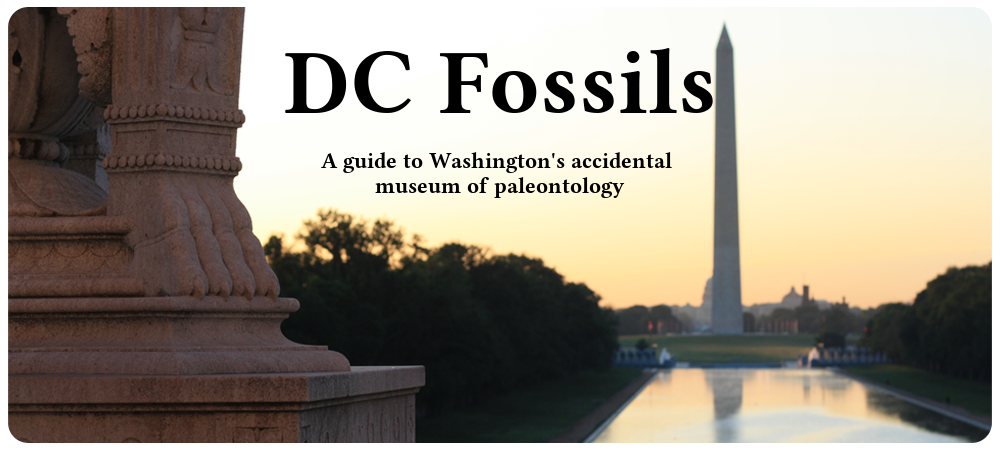Introduction
The Stone and the Fossils
About Crinoids
Acknowledgments and Sources
Visit the northwest corner of 21st and Pennsylvania Ave., N.W. For generations, many Washingtonians associated this corner with motion pictures at the Circle Theater. The Circle Theater opened in 1910 in a Federal-style storefront, but was enlarged and modernized in 1935 along Art Deco lines. It appears as an Art Deco structure in the 1960 photograph below:

(from the archives of the D.C. Historical Society and used with its permission)
Originally opened as a prominent first run theater, the Circle competed with major movie palaces, offering promotions such as free candy to children. Over the decades the Circle sometimes served as a neighborhood theater, and sometimes as a marquee for major releases. In 1957 the Pedas brothers purchased the Circle and made it the anchor of what became a 70 screen local chain. By the 1980s, the Circle had become a second run house, showing double bills of classic and foreign films. Purchasers of the $10 Circle Theater ticket book acquired 10 tickets, each ticket good for an interesting double bill, worn seats, and sticky floors:
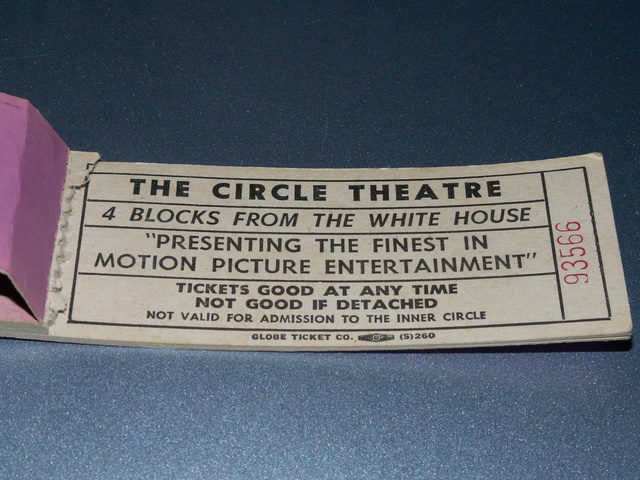
The Circle’s closure in September 1986 prompted fruitless efforts to have it designated a national landmark. To comfort distressed patrons, the Pedas brothers promised that the successor office building would include a movie theater multiplex. The Circle was leveled, and remained a parking lot until the mid-1990s. By 1997, a huge new office building had risen in its place. The new building occupies not merely the corner, but nearly the entire city block bounded by Pennsylvania Ave., 21st St. and K St., as shown below:

The new building, 2121 Pennsylvania Ave., N.W., houses the International Finance Corporation, a part of the World Bank. It was designed by noted Post-Modernist architect Michael Graves, whose style has been characterized as, “Egyptian, classicism, and art deco.” According to a publication on Mr. Graves’ works, this particular building “provides a fresh approach to classical organization and detailing within the context of traditional Washington.” Whatever its architectural character, the new building dramatically transformed the urban character of the block. The massive, single-use structure displaced not only the Circle Theater, but a range of other modest retail and commercial establishments. (In 2006, nearly a decade after its construction, the building opened a single retail outlet, an “artisan market and cafe,” for the public.)
One chronicler of D.C.’s theater history recalled the Pedas’ assurances of a new theater, and plaintively noted that “n 1996, we are still waiting.” It now appears likely that the wait will never end.
The new building does offer one unusual consolation to the neighborhood and the city.
Even the casual pedestrian can easily note that the tan stone of the building has numerous dark shapes. A closer look reveals that the stone is densely crowded with fossils – not eye-straining tiny fossils, but large, well-defined fossils. Particularly vivid are many crinoid stalk segments, as well as shells and others:

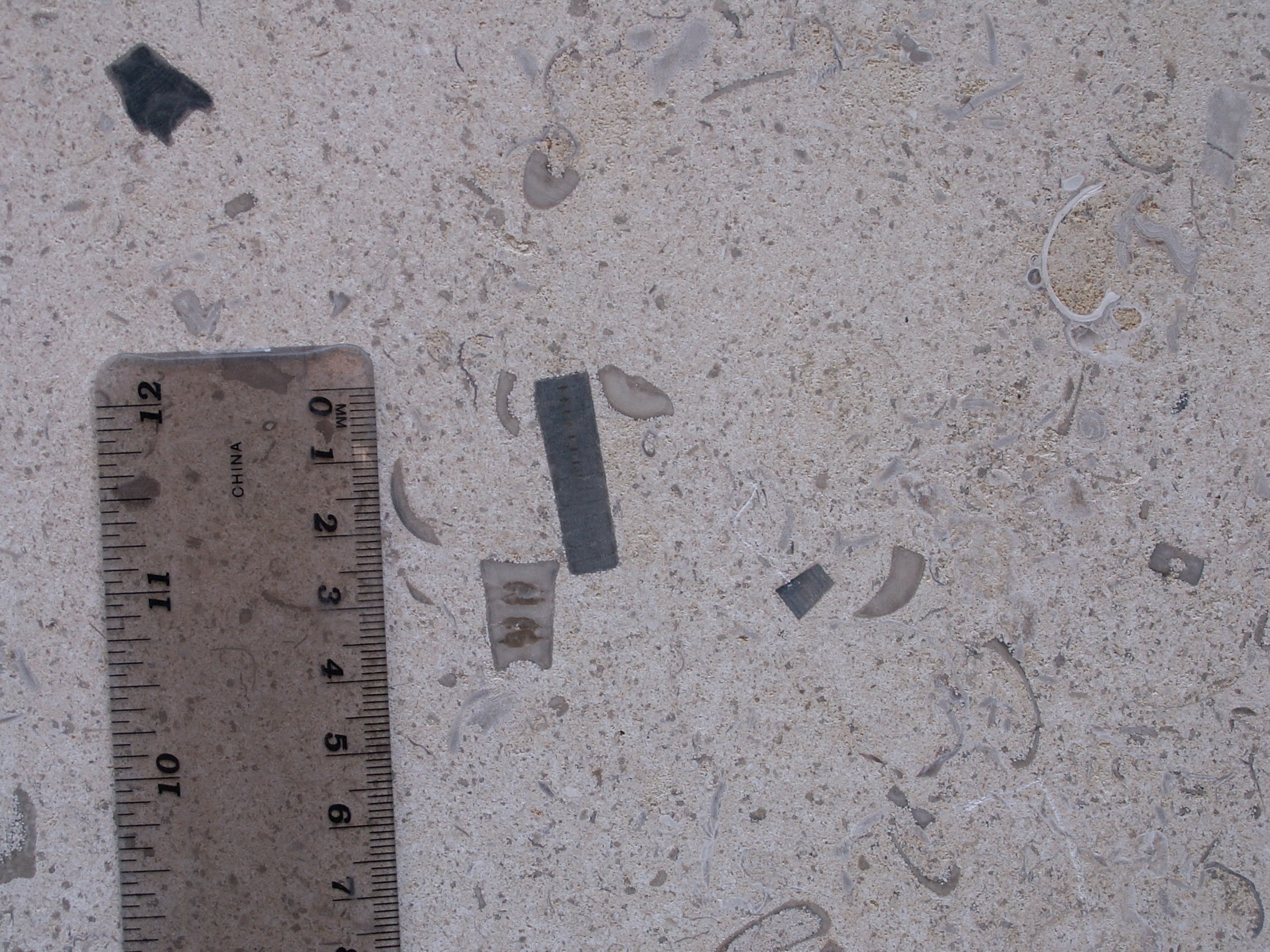
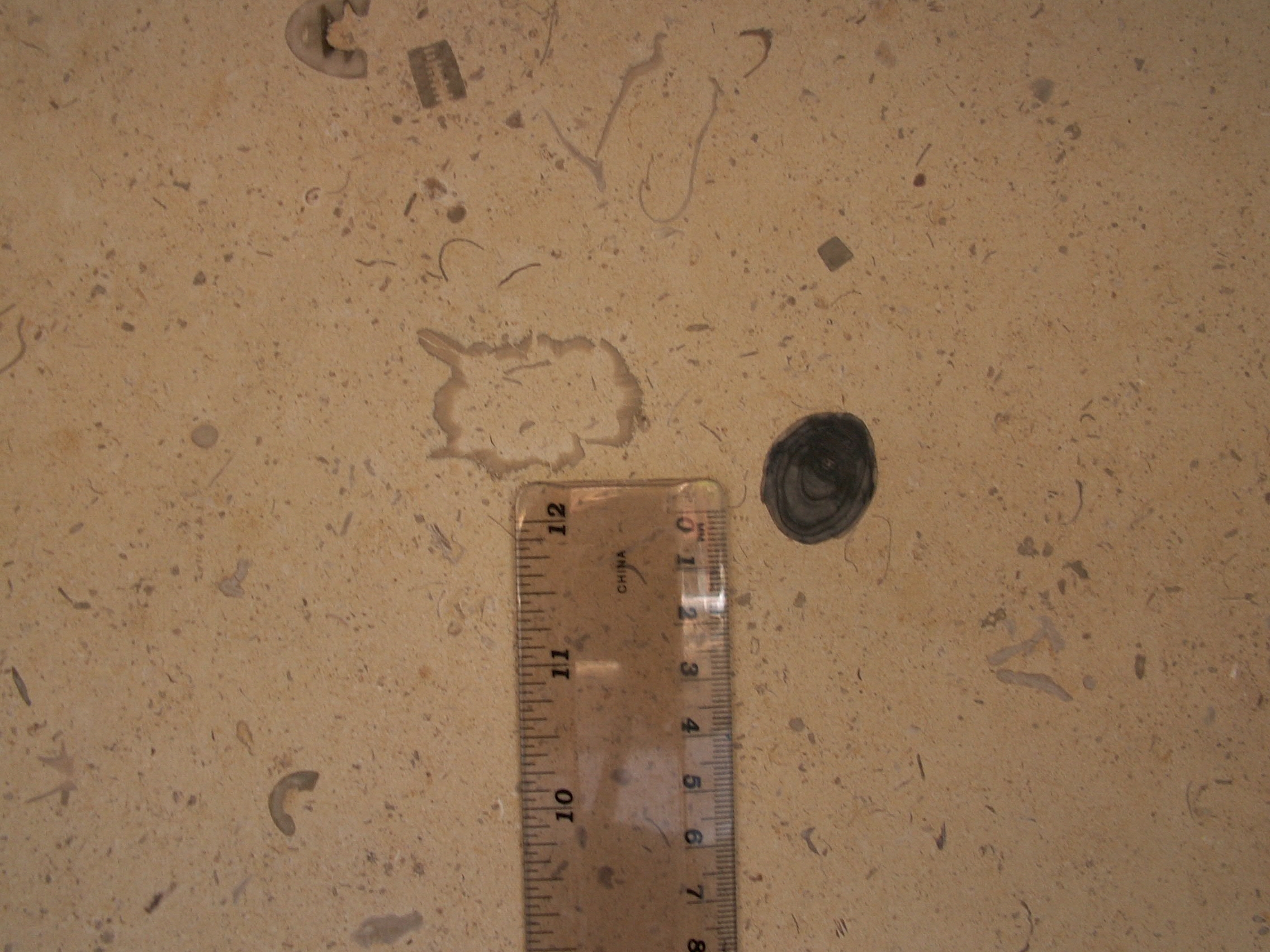
More than 300 yards of fossil exposures wrap around the building, on portions of all three sides.
The Circle Theater is gone, and with it the era of neighborhood single screens and double run theaters.
But there is still a picture show at 21st and Pennsylvania Ave., N.W. And patrons do not even need a $1 ticket to watch.
The stone, known commercially as “Jura Gelb,” or “Jura Marble,” is a Jurassic limestone from southern Germany, from the Jura Mountains – the source of the geological name, “Jurassic.” This limestone was formed from sediments laid down in a shallow sea approximately 160 million years ago. Most of southern Europe was covered by shallow seas at that time, bounded on the south by the deeper waters of the ancient Tethys Sea. (By an interesting coincidence, the café in the IFC Building is named Pangea, which its owners cast as meaning “all lands” – the IFC website describes it as “a celebration and tribute to the spirit and resilience of artisans in developing countries, mainly women” – but “Pangaea” is also the name of the last supercontinent in which all major land masses were physically united and that broke up during the Jurassic period.)
The fossil assemblage that appears in the Jura Gelb is dense and varied, but the most striking fossils are the crinoids, filter-feeding “sea lilies” whose lives and structures are discussed in detail below, with an illustration. Unlike the crinoid fragments that can be seen, often with some eyestrain, in the Salem (Gallery 6) and St. Genevieve (Gallery 7) Limestones, the crinoid fossils here have two advantages: they are often much larger, and portions of crinoid stalks can be seen. Note the large crinoid fossil below, just to the right of the ruler:
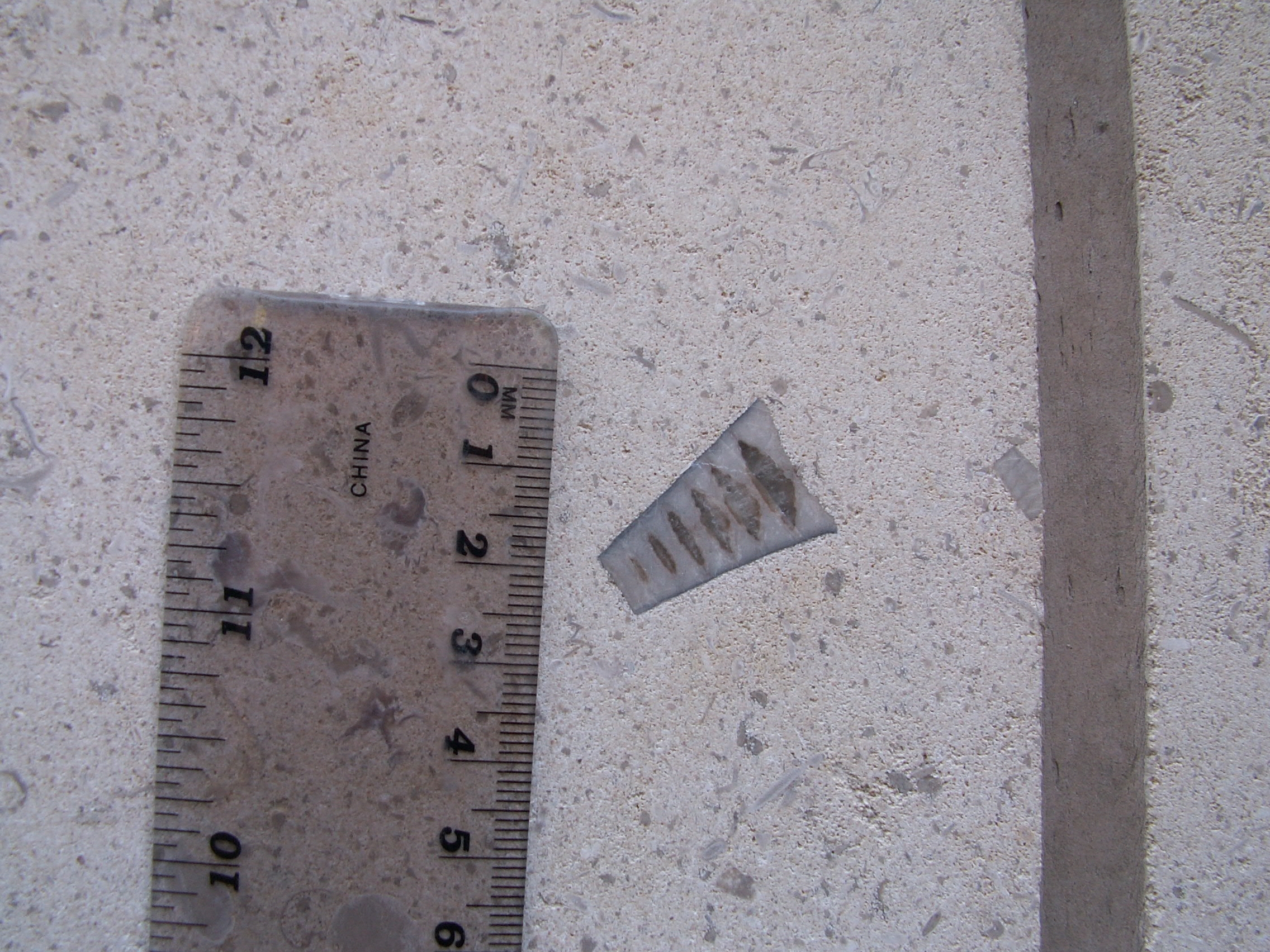
The fossil is a cross-section of a portion of a crinoid column, on its side. The column is made up of a stack of circular discs, joined together by connecting tissue, with an “axial canal” running through the middle of the column. The discs, or “columnals,” here show lens-shaped gaps, where ligaments would have been located.
A different kind of crinoid is visible in this photograph, with thinner columnals and lacking the lens-like spaces between columnals. It is also seen in cross-section and lying on its side:
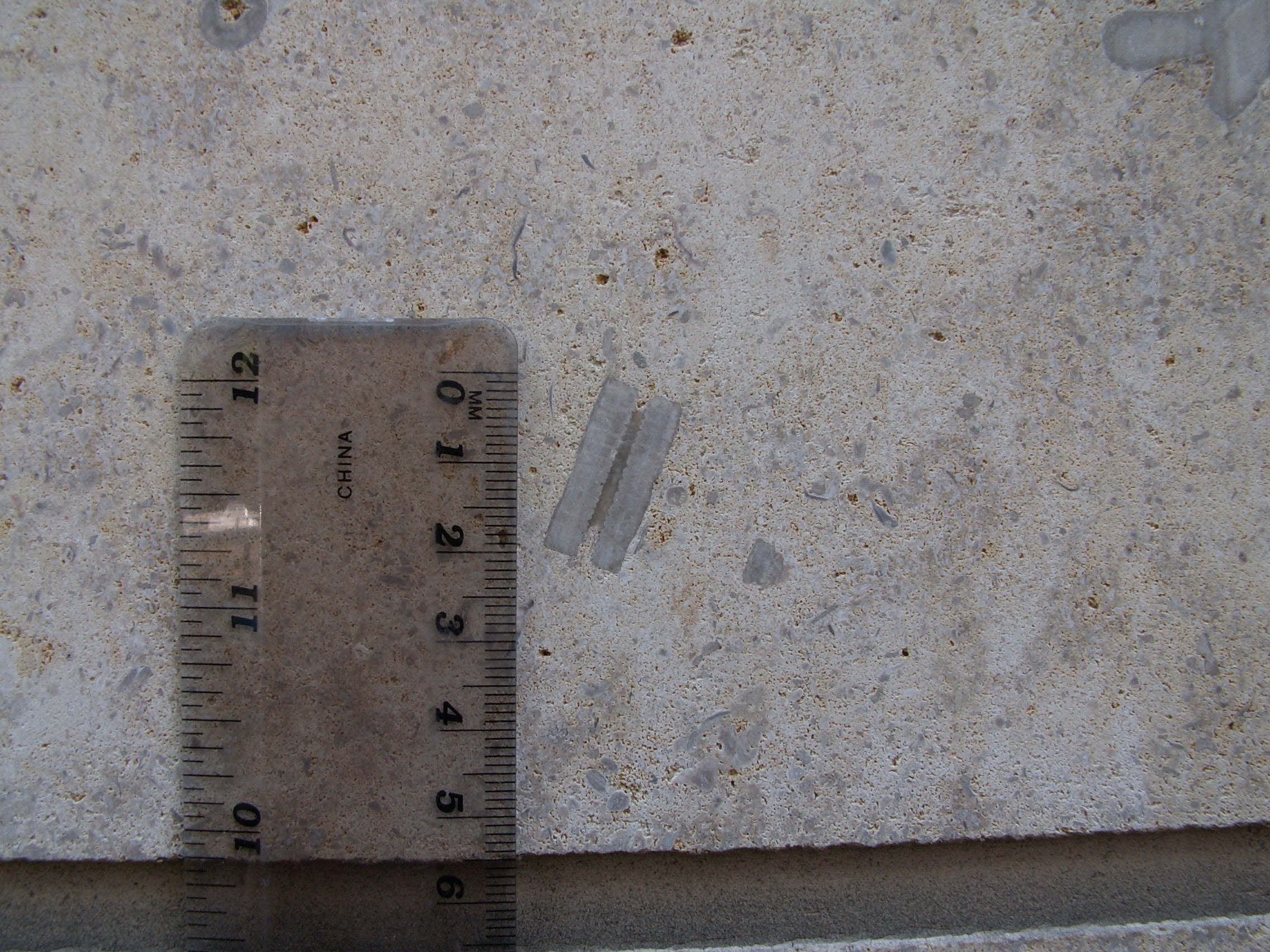
In the crinoid columnals shown above, the axial canal appears to be visible in the middle.
Two different kinds of columnals are shown below, flanking the end of the ruler, in what is typically the more common and easily recognizable views. They appear like “life savers” or metal washers, viewed from the top down:
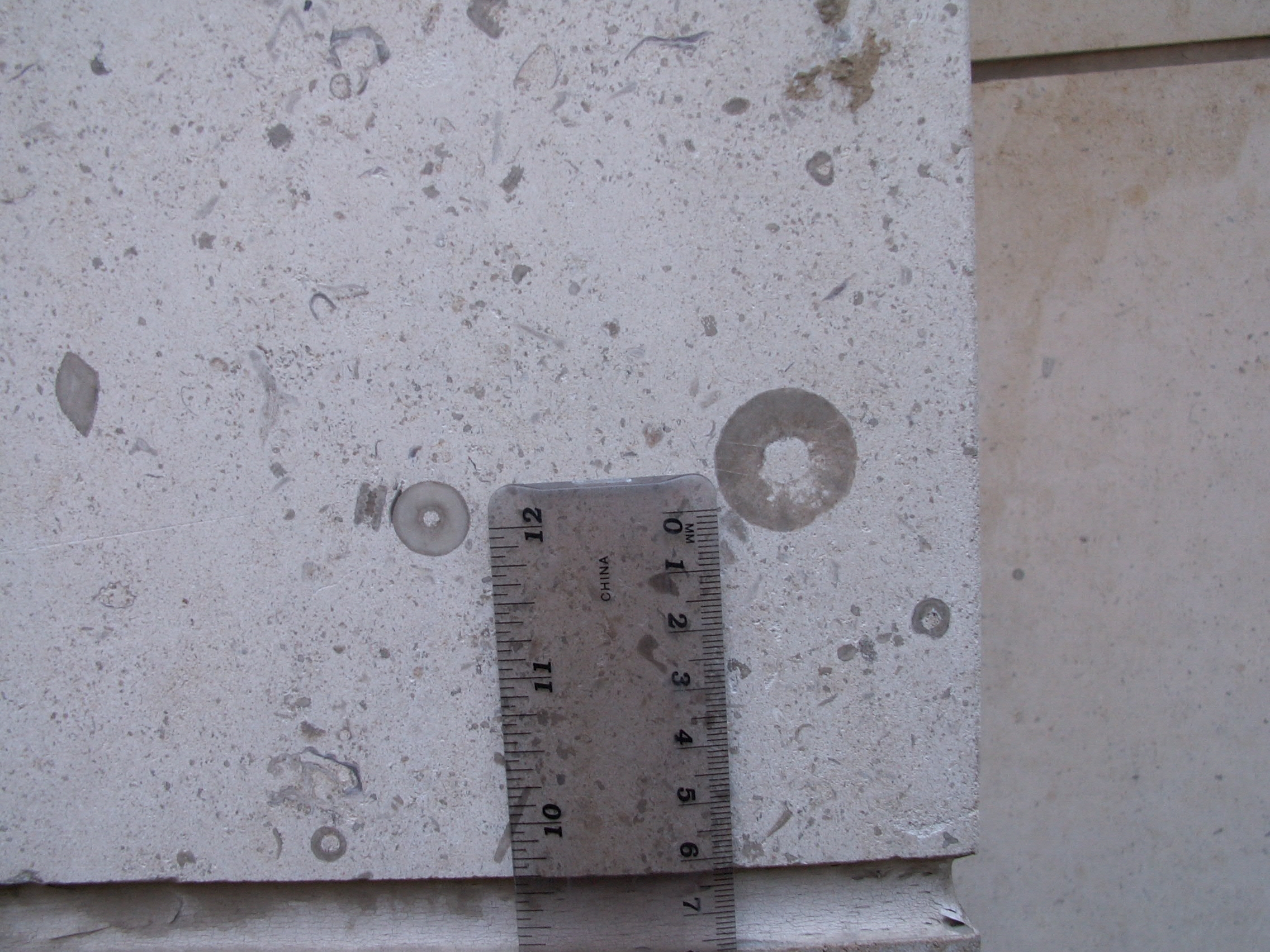
The hole in the middle of the “life saver” is where the axial canal ran down the column, connecting the base of the crinoid with its calyx. Note also that this crinoid appears relatively straight, whereas the section shown in the first picture shows columnals changing in diameter, so that the column flares out. As this difference suggests, there was a great variety of crinoid shapes.
The various other shapes in the tan matrix of the Jura Gelb almost certainly represent other, often less easily recognizable fossils and fossil fragments. In the photograph below, several bivalve shells seem to appear:
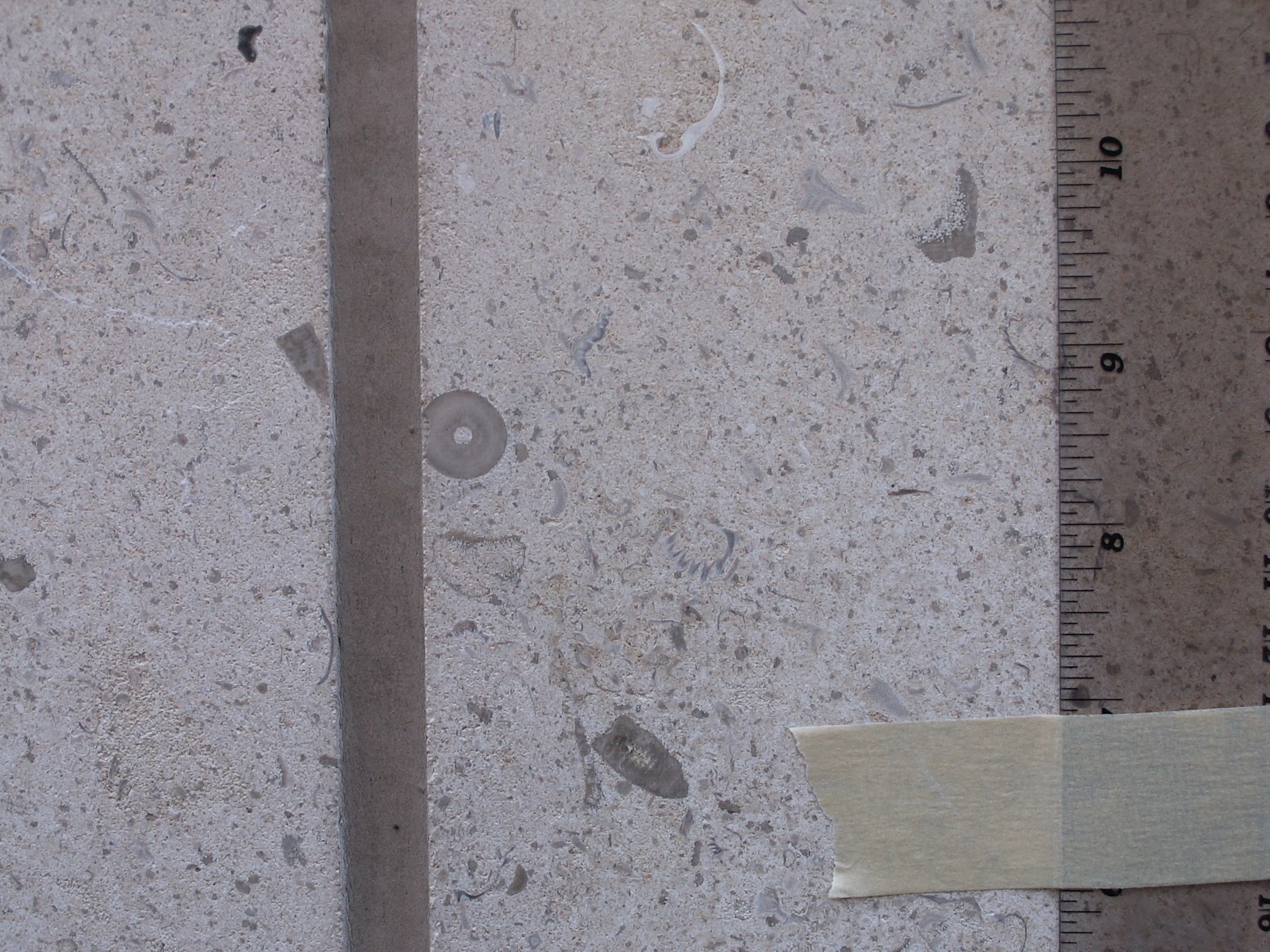
Note the white curved shape approximately 1 ½ inches to the left of the 10 and ½ inch mark on the ruler. This appears to be the hinge of a bivalve. Other bivalve fragments can be seen in the dark curved shapes, like chords of a circle, that appear slightly more than 3 inches to the left of the 7 ½ inch mark (just to the left of the gap between stone panels) and just to the left of the ruler, immediately below the masking tape. Of course, the most easily confirmed fossil is the large crinoid columnal just to the left of the center of the picture.
Numerous curved lines strongly suggesting bivalve shells can also be seen in the picture below:
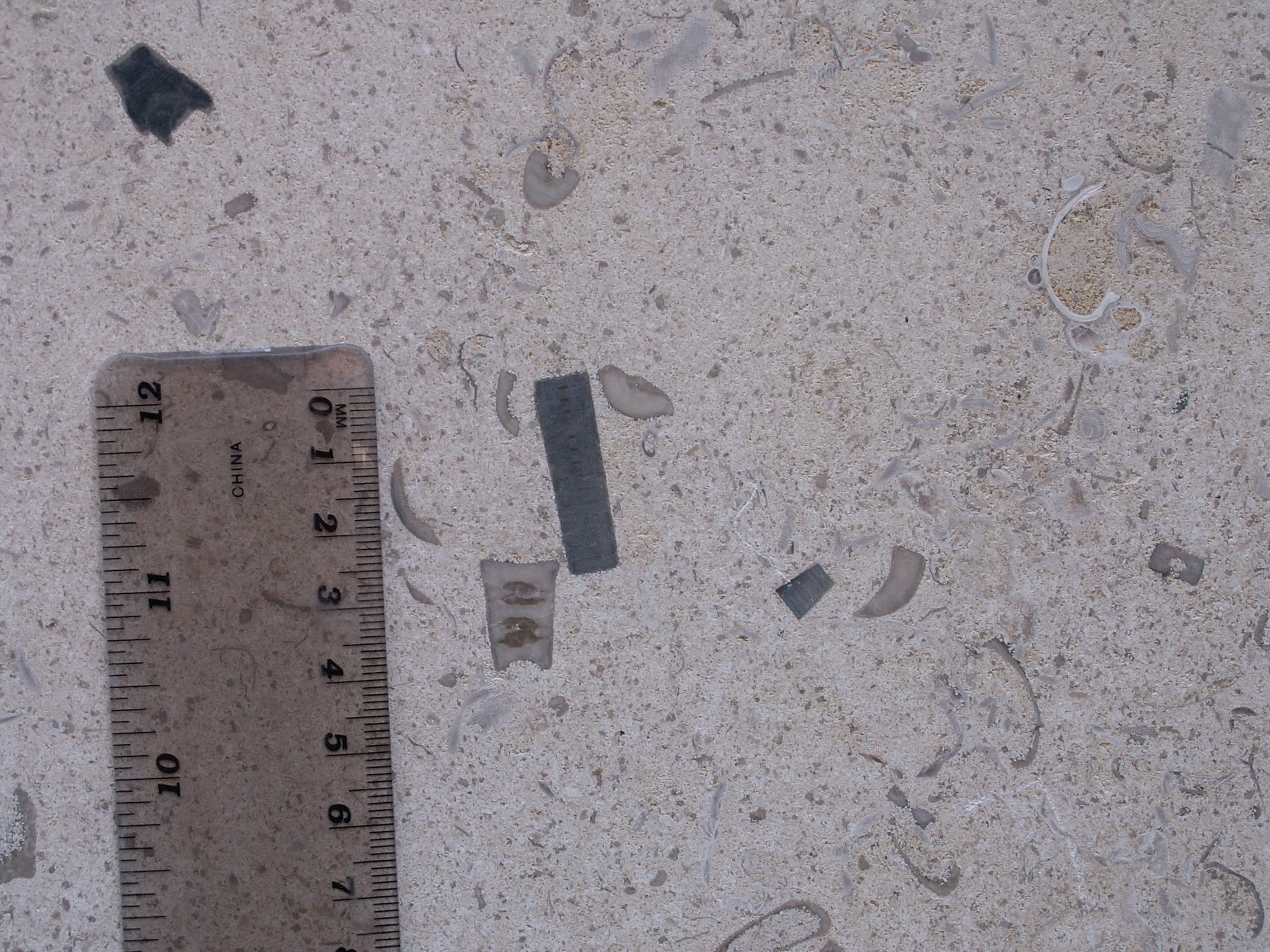
Crinoids are echinoderms – relatives of starfish, sand dollars and numerous other classes of animals, both extinct and living. In life they superficially resemble long-stemmed flowers, hence earning the nickname “sea-lilies” — as the diagram below shows:

Source: Maryland Geological Survey E.S. No. 4, p. 38, Fig. 35
As the diagram illustrates, the principal visible parts consist of “holdfasts” connecting the crinoid to the sediment at the sea bottom, a stem composed of a stack of conjoined, disc-like “columnals,” and a cup-shaped “calyx,” surrounded by arms – all involving hard, skeletal calcareous plates and elements. The arms gathered food such as plankton and channeled it down to a mouth located in the calyx, which also held the principal organs. Crinoids were fairly complex organisms, with well-developed nervous and digestive systems, and a system of fluid-filled tubes, forming a vascular system used to move and secure food.
The entire body is held together by a skin-like tissue, as well as ligaments. Under magnification, the crinoid’s skeletal plates are highly porous, filled with living tissue. After death, the tissue and ligaments would typically be destroyed, so that the skeletal plates of the holdfasts, columnals, calyx and arms would fall apart. Once separated, the fragments making up the arms and calyx are difficult to identify, although the figure below shows the well-preserved, fossilized remains of a nearly complete crinoid:
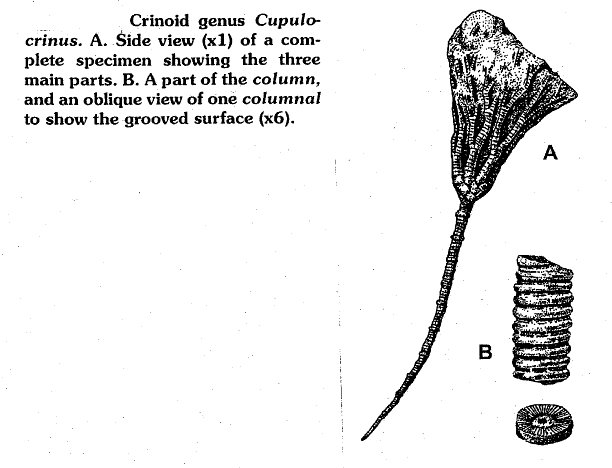
Source: Figure 21, page 17, “Common Fossils of Pennsylvania, Pa. Dept. of Conservation and Natural Resources, Bureau of Topographic and Geologic Survey)
Note the hole shown in the columnal under “B.” It shows the “axial canal” that ran up the entire length of the column and into the holdfasts, containing the axial cord providing nutrition and permitting some degree of control over the holdfasts and the stem. The disc-like, or life-saver-like columnal shown above as “B” is the principal and most abundant type of crinoid fossil.
During the Paleozoic from the early Ordovician through the Permian periods, crinoids were extremely abundant, living in a wide range of habitats, from shallow reefs to sea bottoms 13,000 feet deep. The illustrations above show the standard representations of crinoids, but they varied greatly in size and configuration, from the tiny to the huge (some modern crinoids are up to 60 feet long), as well as some types that floated rather than anchored to the sea bottom. In places, particularly in the shallow seas of the Devonian, Mississippian and Pennsylvanian periods, huge colonies left masses of their hard skeletal remains in beds of stone hundreds of feet deep.
Crinoids are both abundant in the fossil record and common in today’s marine environments. As fossils, their abundance and the visible marks differentiating the columnals have made them a closely studied and useful index fossil.
Acknowledgments and Sources[1]
Identification of the stone. The identification as “Jura Marble” is from a personal communication, Robert Pearlman, IFC. Original Specs: “Jura Marble,” TYP LOTOS, Jura GELB, Source: Germany, Vein: Flueri, Cut from Strata C. Also, Personal communication, Jurassic Stone Co., Al Gregory.
But, noted German crinoid experts Hans Hess and Hans Hagdorn could not confirm that the stone was Jura Gelb based on the photographs, causing some uncertainty over the age and source of the stone. The website discussion has used the official information provided by the owner and stone supplier, but (as always) the author is open to additional comments.
About the history of the Circle Theater. Motion Picture Exhibition in Washington, D.C., An Illustrated History of Parlors, Palaces and Multiplexes in the Metropolitan Area, 1894-1997, by Robert K. Headley (McFarland & Company, Inc., 1999) at 247-248. The picture is from the photographic archives of the District of Columbia Historical Society; the photograph of the Circle Ticket Book is a 2006 photo of the last Circle tickets purchased by the author’s wife circa 1986.
About the architect Michael Graves and his style. Archipedia, essay by Brian Nank at http://archipedia.com/Architects/Michael-Graves.html”, provides the quote about Mr. Graves’ general style. The quote regarding 2121 Pennsylvania Ave. is from the book, Michael Graves, Buildings and Projects 1995-2003, ed. Karen Nichols (Rizzoli, New York 2003). The book does not mention the fossils in its discussion of the IFC Building, although interestingly, Mr. Graves also chose a fossiliferous limestone for portions of the exterior of his 1995 Denver public library.
About Crinoids. “Common Fossils of Pennsylvania, Pa. Dept. of Conservation and Natural Resources, Bureau of Topographic and Geologic Survey; “Collecting Fossils in Maryland,” E.S. No. 4, Maryland Geological Survey “Collecting Fossils in Maryland,” E.S. No. 4, Maryland Geological Survey; “Fossil Crinoids,” H. Hess, W.I. Ausich, C.E. Brett, M. Simms, (Cambridge University Press 1999); The Fossil Book, A Record of Prehistoric Life, Carroll Lane Fenton and Mildred Adams Fenton (rev. ed., 1989) at 302 -314. The author strongly recommends in particular “Fossil Crinoids” as a clear, well-written and detailed treatment of the subject.
[1] Where this website cites specific internet page addresses, they are typically the addresses used by the author in researching and writing this discussion – a process taking several years. Unfortunately, in the meantime a number of the specific addresses have changed, and will continue to change, rendering some of these addresses ineffective as links. Readers should be able to find the material by searching for the proper name of the cited article or material on a search engine.
